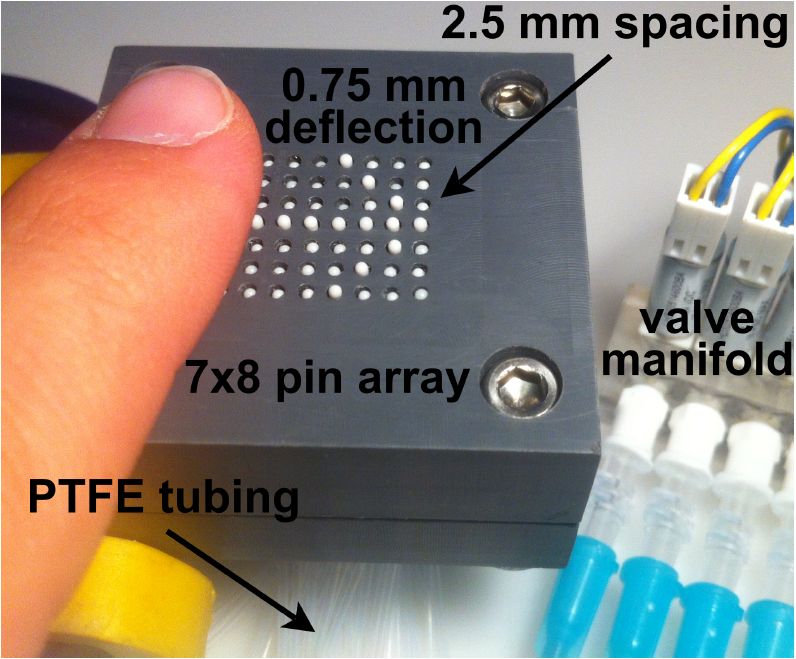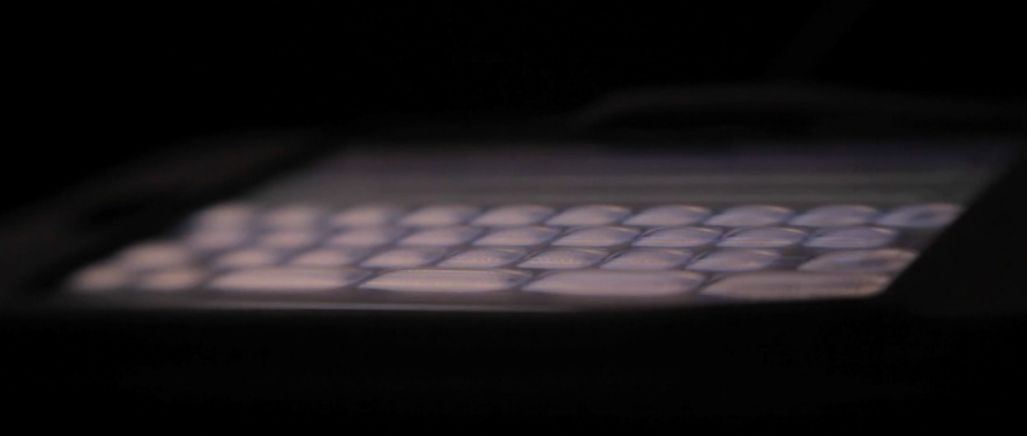
Haptic screens bulge with sensory information
Because these implementations are typically bulkier and non-transparent, they would not qualify for integration into smartphones and tablets, but may be convincing as enhanced table top keyboards.
Researchers from the Keio University (Yokohama, Japan) designed a MEMS tactile display to create virtual surface textures. The small prototype unit features large-displacement MEMS actuators underneath a titanium faceplate with 0.48mm diameter holes in it.
Each large-displacement MEMS consists of a piezoelectric actuator pushing a plastic piston through a cavity filled with an incompressible polymer fluid that pushes its way through a deformable latex membrane.


Upon actuation, the hydraulic amplification mechanism squashes the fluid and makes the small latex membrane bulge through the faceplate hole. For a good discrimination through a finger’s tactile receptors, the tactile pixels were spaced a few millimetres apart, with the bulges protruding over 100μm at several Hz, and several μm at high frequencies up to 200Hz.
By controlling the displacement, the vibration frequency, and the actuator driving patterns, the researchers reported various tactile feelings, mimicking various surface textures such as wood, urethane foam, and sandpapers.
Researchers from the University of Michigan detailed a tactile display prototype using pneumatics to actuate a 7×8 array of pins, 1.2mm in diameter and spaced 2.5mm apart, with a clear orientation to haptically-encode information to visually impaired users (such as braille and tactile graphics).

You may call it the steampunk of haptic displays, with pressurized air routed via small pipes to move the sliding pins up (with a 0.75mm vertical course). Pushed upwards, the pins deflect a thin elastic membrane and protrude from the faceplate. The system has a fairly slow refresh rate just under 2Hz, which really makes it applicable to Braille reading but would fall short of simulating textures and “click” feels.
At the CEA’s Sensorial and Ambient Interfaces Laboratory, researchers came up with an interesting piston-variant of the bulging haptic display.
In a paper titled “Morphing Tactile Display for Haptic Interaction in Vehicles”, co-authored by research engineers from car maker Renault, the CEA LIST lab described a tactile display based on an array of 32 electromagnetic actuators (individual coils with composite iron/aluminium cores) overlaid by a capacitive touch deformable layer for finger position detection.
 A matrix of thin copper wires moulded into an elastic silicone support makes the deformable touch screen, with taxels that can move out of plane up to 1.9mm and a two-stage locking mechanism makes them bi-stable so as to reduce power consumption. In its current implementation, the device which is to be integrated in the centre console of vehicles has a reported refresh rate of 2Hz.
A matrix of thin copper wires moulded into an elastic silicone support makes the deformable touch screen, with taxels that can move out of plane up to 1.9mm and a two-stage locking mechanism makes them bi-stable so as to reduce power consumption. In its current implementation, the device which is to be integrated in the centre console of vehicles has a reported refresh rate of 2Hz.
At a reasonable deformation of about 0.25mm, a force of about 1.25N can be applied to the device, which would provide enough haptic feedback to give a “clicking impression” to the user. The researchers hope to redesign their system with a higher actuator density, packing 289 taxels spaced about 3mm apart to enable a non-pixelated surface shape.
Slightly different but qualifying as a bulging screen, Tactus Technology’s Tactile Layer panel, showcased two years ago at SID 2012, relies on a transparent layer of microfluidics to raise liquid-filled bumps over ordinary touch-LCDs, creating dynamic physical buttons that users can see and feel.
With a refresh rate about 1Hz, this interface is clearly aimed at keyboard-on-screen implementations. Tactus Technology claims it could create almost any type of button configuration or layout on a panel (set in the manufacturing process). The company has yet to find a tablet or smartphone partner to integrate the pumped-up keyboard to their offering.

Tactus’ Tactile Layer panel with a raised QWERTY keyboard button layout.
Related articles:
Augmented reality gets physical with haptics
NXP backs Senseg’s electrostatic touch
Haptic lens converts light into touch
Aito raises €2m for piezo sensors
Haptic display/keyboard uses microfluidics to make buttons rise
 If you enjoyed this article, you will like the following ones: don't miss them by subscribing to :
eeNews on Google News
If you enjoyed this article, you will like the following ones: don't miss them by subscribing to :
eeNews on Google News



